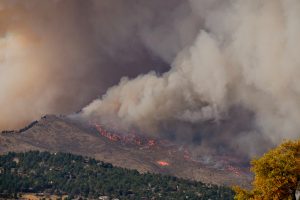Aug. 14, 2023

Advanced sensors used by UCI’s Computer Vision Laboratory can track fires through smoke and quantify emissions from gases like CO2, carbon monoxide, methane, and ammonia.
The newest lab at CALIT2, the Computer Vision Laboratory (CVL), is at the forefront of an innovative field that transcends the limits of human vision. Specializing in the modeling and automated analysis of hyperspectral and multispectral images, CVL researchers are working to unlock the hidden potential in data collected by advanced sensors. Led by Glenn Healey, CVL’s director and a professor in electrical engineering and computer science at UCI, the lab boasts a diverse and multidisciplinary team with expertise spanning physical modeling, signal/image processing, numerical analysis and machine learning.
Unlocking the secrets of the spectrum: From butterflies to fires
Visible light, often equated with what we perceive as color, is merely a fragment of the electromagnetic energy spectrum which includes the visible and the invisible from radio waves to Gamma rays. While human vision is confined to the narrow band between 400 and 700 nanometers, researchers have developed cameras capable of capturing wavelengths far beyond the scope of human sight.
While humans can distinguish color using three primary filters (approximately red, green and blue), the nuanced vision of a butterfly employs six or more color filters. This superior color vision enables the butterfly to navigate its floral habitat with stunning accuracy. Advanced cameras like those used by the CVL exploit hundreds or even thousands of color channels. “We can build cameras that sense wavelengths that people can’t see and tune their response to very specific spectral bands,” Healey says. The result is hyperspectral and multispectral imaging, where each pixel holds a wealth of information from the specific wavelengths that it captures.
Botanical clues: Detecting fire prone vegetation
These cutting-edge sensors herald a revolutionary era for fire detection and analysis. CVL’s researchers are actively deploying hyperspectral and multispectral image sensors as vital components of ALERTCalifornia, an innovative initiative aimed at enhancing resilience and preparedness against wildfires. Central to their efforts is seamless monitoring of vegetation chlorophyll and moisture content. By scrutinizing reflections across various wavelengths, researchers unearth insights into plant health and moisture levels. This knowledge is pivotal for predicting fires, assessing risks and enabling swift responses to potential threats. Following a fire event, this technology is also used to assess fire severity and to track vegetation recovery over time.
The research extends to analyzing temperature patterns, empowering sensors to detect even minuscule temperature increases. This ability translates into early fire detection, enabling quicker firefighting responses. Healey underscores its importance, stating, “Within a second of a fire starting, you have information, `there’s rising temperature over there, pay attention.'” These rapid-response capabilities prove invaluable in managing wildfires before they intensify. These sensors are also able to track fires through smoke and to quantify emissions from gases like CO2, carbon monoxide, methane and ammonia. This provides valuable information for protecting firefighters and enhances understanding of fire behavior and its effect on air quality. Even in the absence of fires, hyperspectral sensors support the continuous wide-area generation of air quality assessments that include PM2.5 as well as the concentrations of its component aerosol types.
A Vision for the future
The versatile sensors can be deployed from towering observation posts to agile drones. “We’ve been testing a unique set of multiband sensors by collecting visible through long-wavelength infrared images at various locations across southern California,” Healey says. He envisions a future where these innovations become widely accessible, fortifying communities and preserving the environment. He expresses his optimism, “When we demonstrate what we can do with this technology, I think we’ll see these sensors used in many places.”
The far-reaching implications of CVL’s imaging research is poised to transform firefighting strategies and transform hazard detection, fire monitoring and environmental assessment. CVL’s research holds the promise of introducing inventive tools and methods that contribute to safeguarding lives and protecting properties from the devastating impact of wildfires.
The Computer Vision Laboratory moved into the CALIT2 building this summer. The lab is located on the second floor in room 2402.
– Sharon Henry
